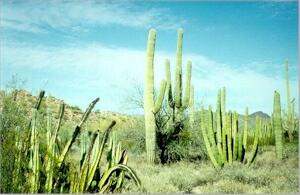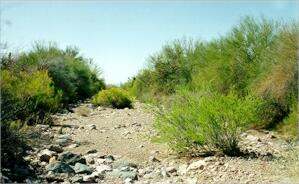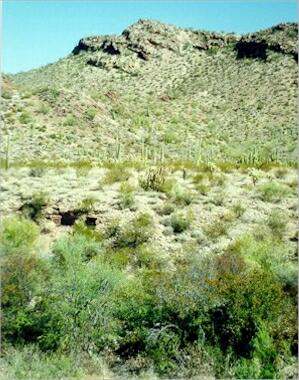SONORAN DESERT The Sonoran Desert is a subtropical desert with very rich species diversity. Part of this diversity is caused by the complex geology of this region, leading to a mixture of soil types. Part is caused by the virtual absence of frost, so that succulent, tender plants can survive. But the major reason is that this desert receives rainfall twice a year - light, prolonged rains in winter, and heavier downpours in summer. This twice-yearly pattern of rainfall promotes the growth of both winter annuals and summer annuals (whereas only winter annuals are found in the Mojave Desert and only summer annuals in the Chihuahuan Desert). The twice-yearly rainfall also relieves some of the drought-stress of perennial plants, which do not have to survive long periods without water. Having said this, quite large areas of the Sonoran Desert consist of low-lying, flat valley floors, where temperatures are very hot and there is little rainfall. These areas are dominated by widely spaced creosote bush or a mixture of creosote bush and bur sages. In contrast, the higher regions around Phoenix and Tucson - an area termed the Arizona Upland Division - have cooler average temperatures and higher rainfall. These areas can support a rich variety of plants, especially on the gentle slopes (bajadas) where the products of mountain erosion accumulate. View of part of the Arizona Upland Division of the Sonoran Desert. A 'forest' of saguaro cacti and subtrees (mainly paloverde) is seen on the bajada at higher elevations in the foreground. The land flattens to a valley floor in the middle distance where (across the centre of the image) there is a strip of urban development. The lowest-lying land in the shadow of the mountains (far distance) receives little rain. Here the vegetation is poor and dominated by creosote bush.
Bajadas support a rich diversity of plants because the soils are quite deep, with a mixture of particle sizes ranging from fallen rocks to gravels, sands and silts. The open structure of these soils enables water to penetrate and be retained deep in the soil profile, whereas the more tightly packed soils of flatter regions become saturated easily so that most of the water runs off them during heavy rains. The plant transitions in these sites are very obvious. For example, in the right-hand image above, a mixture of creosote bush and bursage in a flat, sandy or silty area is replaced within a few metres by a range of tall, columnar cacti, ocotillo, several cholla cacti and foothills paloverde as the land rises up a bajada. Two further examples of this sort of transition are shown below.
The two images below illustrate the diversity of large cacti in parts of the Arizona Upland Division of the Sonoran Desert.
A further level of species diversity is provided by the river beds (washes) that periodically carry large amounts of drainage water from the surrounding mountains. Even though these washes are dry for most of the year, the moisture tends to be retained in the soil. Lining these washes is a range of shrubs, trees, and smaller flowering plants that benefit from the soil moisture content. They include mesquite, acacia, hopbush, paloverde, mexican jumping bean, chuparosa, canyon ragweed and Parry's penstemon.
The Sonoran Desert in Mexico Deserts do not recognise international boundaries. The Sonoran Desert extends from southwestern USA into mainland Mexico (the state of Sonora) and into the Baja California peninsula. In these hotter, more tropical regions there is an even wider diversity of plants, many of them being unique to this region. They include many large cacti and other succulents that cannot tolerate frost. See Baja California desert
|
||||||||||








